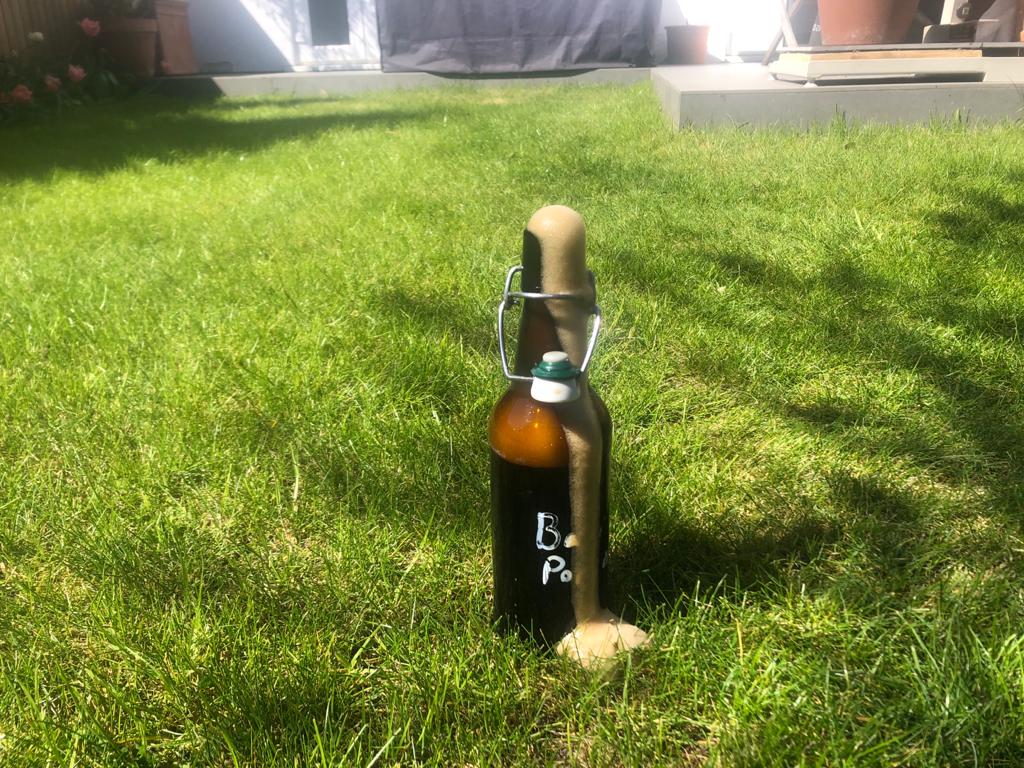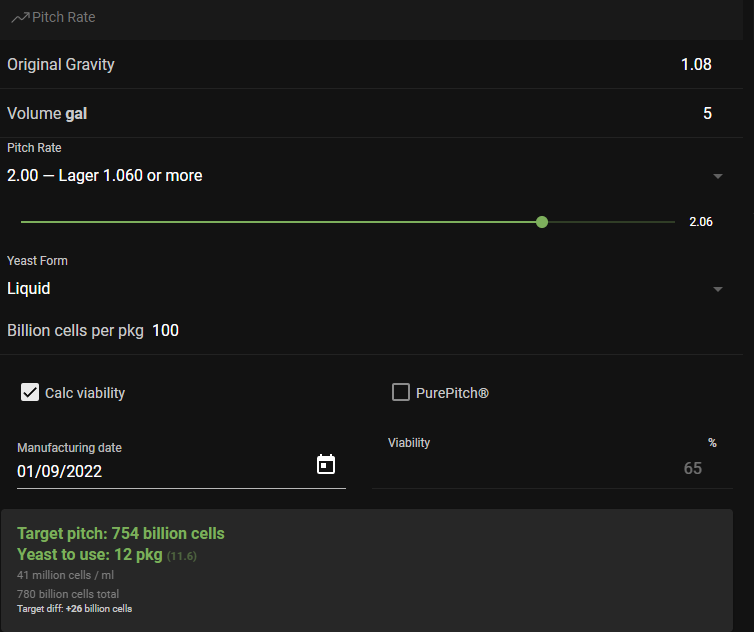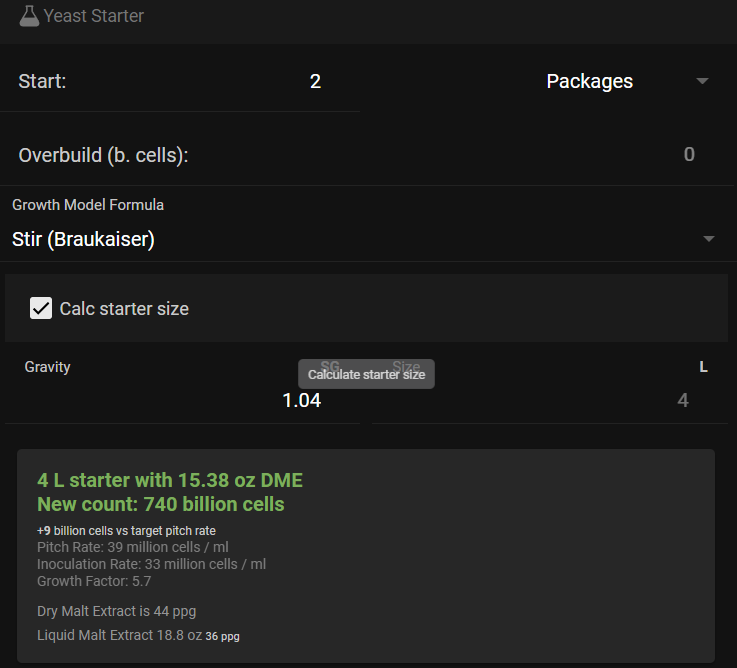Im a new brewer and learning the hard way I need to think ahead a little more before getting started. I've brewed a 5 gallon doppelbock and this is the first time I've made something this strong with an OG of about 1.080. For yeast, I only bought one pack of White Labs WLP833 German Bock Lager yeast, and at the time to pitch I'm realizing that I should have either made a yeast starter or bought 3 packs of yeast. I ended up letting the brew sit in a warmer place (65ish degrees) for 24 hours until it started bubbling every 30 seconds or so before moving it to a colder (51deg) place to ferment. I'm wondering if I should still buy and pitch another yeast packet or two, or what would happen if I just let it ferment as is?
You are using an out of date browser. It may not display this or other websites correctly.
You should upgrade or use an alternative browser.
You should upgrade or use an alternative browser.
Dopplebock yeast quantity
- Thread starter Wesori
- Start date

Help Support Homebrew Talk:
This site may earn a commission from merchant affiliate
links, including eBay, Amazon, and others.
If you leave it as is, it could be OK. If you do this though, the worst case scenario is if the yeast appear to be at FG but in reality they are just slowly working and then you bottle. These could become bottle bombs. The best case scenario is that it'll be fine. The in-between scenario is that it'll stall.
If you pitch more yeast, you're going to have to make a starter and pitch while active.
If it were me, I'd (1) leave it as is and hope for the best, (2) raise temp as the activity is dying-down to help the yeast along, (3) give it extra time in the fermenter, and (4) if I think there's the slightest chance of bottle bombs I'd drink it as fast as I could in the interest of safety.
If you pitch more yeast, you're going to have to make a starter and pitch while active.
If it were me, I'd (1) leave it as is and hope for the best, (2) raise temp as the activity is dying-down to help the yeast along, (3) give it extra time in the fermenter, and (4) if I think there's the slightest chance of bottle bombs I'd drink it as fast as I could in the interest of safety.
If you have 3-4 days between stable gravity readings, I wouldn't worry about bottle bombs.
3-4 days of stable gravity usually works fine... unless you dramatically underpitch. I found this out the hard way with a Baltic Porter earlier in the year. The bottles never actually exploded, but it took me two days to clean the room in my house where I opened the gushing bottle. I bottled with a stable gravity reading over six days. The airlock was going ultra slow though, execept for the last couple days. But it had stable gravity, so I thought it was just degassing.If you have 3-4 days between stable gravity readings, I wouldn't worry about bottle bombs.
For the remaining bottles, I bled the pressure and discovered it was bottled eight points above FG. It took eight weeks to move the eight points.

davidabcd
Detroit, Mi.
- Joined
- Jul 19, 2018
- Messages
- 3,326
- Reaction score
- 4,430
You bottled with a FG eight points above what the recipe or predicted FG was supposed to be?For the remaining bottles, I bled the pressure and discovered it was bottled eight points above FG. It took eight weeks to move the eight points.
How much did you dramatically under pitch?
Even using a packet of dry yeast for a 10% beer hasn't had those kind of effects and that was for about ten or fifteen batches.
Readings four days apart will logically give at least a little difference if the beer is fermenting.
Was an infection ruled out?
Cheers.

$33.99 ($17.00 / Count)
$41.99 ($21.00 / Count)
2 Pack 1 Gallon Large Fermentation Jars with 3 Airlocks and 2 SCREW Lids(100% Airtight Heavy Duty Lid w Silicone) - Wide Mouth Glass Jars w Scale Mark - Pickle Jars for Sauerkraut, Sourdough Starter
Qianfenie Direct

$176.97
1pc Commercial Keg Manifold 2" Tri Clamp,Ball Lock Tapping Head,Pressure Gauge/Adjustable PRV for Kegging,Fermentation Control
hanhanbaihuoxiaoshoudian

$719.00
$799.00
EdgeStar KC2000TWIN Full Size Dual Tap Kegerator & Draft Beer Dispenser - Black
Amazon.com

$76.92 ($2,179.04 / Ounce)
Brewing accessories 1.5" Tri Clamp to Ball Lock Post Liquid Gas Homebrew Kegging Fermentation Parts Brewer Hardware SUS304 Brewing accessories(Gas Hose Barb)
chuhanhandianzishangwu

$44.99
$49.95
Craft A Brew - Mead Making Kit – Reusable Make Your Own Mead Kit – Yields 1 Gallon of Mead
Craft a Brew

$22.00 ($623.23 / Ounce)
AMZLMPKNTW Ball Lock Sample Faucet 30cm Reinforced Silicone Hose Secondary Fermentation Homebrew Kegging joyful
无为中南商贸有限公司

$7.79 ($7.79 / Count)
Craft A Brew - LalBrew Voss™ - Kveik Ale Yeast - For Craft Lagers - Ingredients for Home Brewing - Beer Making Supplies - (1 Pack)
Craft a Brew

$20.94
$29.99
The Brew Your Own Big Book of Clone Recipes: Featuring 300 Homebrew Recipes from Your Favorite Breweries
Amazon.com
![Craft A Brew - Safale S-04 Dry Yeast - Fermentis - English Ale Dry Yeast - For English and American Ales and Hard Apple Ciders - Ingredients for Home Brewing - Beer Making Supplies - [1 Pack]](https://m.media-amazon.com/images/I/41fVGNh6JfL._SL500_.jpg)
$6.95 ($17.38 / Ounce)
$7.47 ($18.68 / Ounce)
Craft A Brew - Safale S-04 Dry Yeast - Fermentis - English Ale Dry Yeast - For English and American Ales and Hard Apple Ciders - Ingredients for Home Brewing - Beer Making Supplies - [1 Pack]
Hobby Homebrew

$49.95 ($0.08 / Fl Oz)
$52.99 ($0.08 / Fl Oz)
Brewer's Best - 1073 - Home Brew Beer Ingredient Kit (5 gallon), (Blueberry Honey Ale) Golden
Amazon.com

$53.24
1pc Hose Barb/MFL 1.5" Tri Clamp to Ball Lock Post Liquid Gas Homebrew Kegging Fermentation Parts Brewer Hardware SUS304(Liquid Hose Barb)
yunchengshiyanhuqucuichendianzishangwuyouxiangongsi

$58.16
HUIZHUGS Brewing Equipment Keg Ball Lock Faucet 30cm Reinforced Silicone Hose Secondary Fermentation Homebrew Kegging Brewing Equipment
xiangshuizhenzhanglingfengshop

$479.00
$559.00
EdgeStar KC1000SS Craft Brew Kegerator for 1/6 Barrel and Cornelius Kegs
Amazon.com

$53.24
1pc Hose Barb/MFL 1.5" Tri Clamp to Ball Lock Post Liquid Gas Homebrew Kegging Fermentation Parts Brewer Hardware SUS304(Gas MFL)
Guangshui Weilu You Trading Co., Ltd
davidabcd
Detroit, Mi.
- Joined
- Jul 19, 2018
- Messages
- 3,326
- Reaction score
- 4,430
I'm with many on this: it's fine.OG of about 1.080. For yeast, I only bought one pack of White Labs WLP833 German Bock Lager yeast,
Looking back the recipe I was expecting somewhere between 1.021 to 1.018 for FG. I bottled at 1.021 and it ended-up at 1.013. I did mash on the low side.You bottled with a FG eight points above what the recipe or predicted FG was supposed to be?
How much did you dramatically under pitch?
Even using a packet of dry yeast for a 10% beer hasn't had those kind of effects and that was for about ten or fifteen batches.
Readings four days apart will logically give at least a little difference if the beer is fermenting.
Was an infection ruled out?
Cheers.
Thought there was a chance it was an infection at first. It tasted fine though once done (and pressure relieved) and when the gravity was stable, it was for a week or so.
For 26 litres (6.8 gallons) @ 1.080, I pitched two Wyeast 2206 packs. If I recall correctly, they only swelled a little bit and I pitched cold.
I have had better luck with dry yeast as well and I'm using more of it these days.
@Wesori hopefully is fine, but knowing the worst that could (not will) happen might help.
davidabcd
Detroit, Mi.
- Joined
- Jul 19, 2018
- Messages
- 3,326
- Reaction score
- 4,430
I don't see anything off there except maybe the 1.013 FG and I'm not sure if that's a possible byproduct of mash temp. The mystery is still the gravity not moving so many days apart. The only thing that makes sense is infection since you did the readings and all that. I'm assuming it spent some decent time in the primary. Over-priming the bottles is stillLooking back
Maybe some others would, but I wouldn't call two packs "under pitching." One pack might have been a little light for the batch size but opinions vary. I was considering a severe under-pitch could have left the batch open to infection but I don't think so at all now because of two.
And pitching cold is what it is--just give a bit of a delay.
Dry is just too easy for me to pass up--two packs, bam, done. I do 5gal/19l and big ABVs though 10%-plus.
Edit: over priming doesn't account for the big FG change.
Last edited:
For priming bottles, I use the calculator on my own site: Brewingcalculators.com - Priming Sugar . The equation is from the Hall paper in Zymurgy 1995 and the amount of sugar I used for the Baltic Porter was reasonable compared with other calculators as well (140g sugar for the 23.5 litres bottled).I don't see anything off there except maybe the 1.013 FG and I'm not sure if that's a possible byproduct of mash temp. The mystery is still the gravity not moving so many days apart. The only thing that makes sense is infection since you did the readings and all that. I'm assuming it spent some decent time in the primary. Over-priming the bottles is still off the table. You know that chart for priming from Brewer's Friend where it talks about calculating the priming sugar based on the temperature that the beer was fermented at? I've run into that and got some gushers.
Maybe some others would, but I wouldn't call two packs "under pitching." One pack might have been a little light for the batch size but opinions vary. I was considering a severe under-pitch could have left the batch open to infection but I don't think so at all now because of two.
And pitching cold is what it is--just give a bit of a delay.
Dry is just too easy for me to pass up--two packs, bam, done. I do 5gal/19l and big ABVs though 10%-plus.
I put all this in a thread last year: Why underpitching yeast is bad. Worst (almost) case scenario. | Homebrew Talk - Beer, Wine, Mead, & Cider Brewing Discussion Forum
You may be right, and it may have been an infection. If it was though, it quit at 1.013, and it was a good tasting infection!
davidabcd
Detroit, Mi.
- Joined
- Jul 19, 2018
- Messages
- 3,326
- Reaction score
- 4,430
That's funny.If it was though, it quit at 1.013, and it was a good tasting infection!
"Over priming due to temp" was actually a bad idea on my part considering all the info from the FG. I didn't think of that til later.
I remember that thread--wasn't too long ago.
The only thing I've had happen similarly (gravity readings aside but results looked just like yours) was when I added fruit to a wheat beer. I think the fruit started fermentation anew and I didn't account for it. Gushers all around. More disappointing was that the fruit flavor was perfect and I ignored all suggestions of backsweetening.
So I just stick to stouts, old ales and triples these days.
I've done enough split batch yeast pitch experiments to know that underpitching is a major hitch in producing "excellent" beer. I'm not saying that underpitched beers won't ferment and usually reach final gravity. I'm suggesting that it generally makes estery lagers (not appropriate for the style) that often have other off flavor problems like diacetyl and acetaldehyde.
For yeast, I only bought one pack of White Labs WLP833 German Bock Lager yeast, and at the time to pitch I'm realizing that I should have either made a yeast starter or bought 3 packs of yeast.
One major factor is how old the pack was also. It loses about 50% viability every month it is in the package.
Let's be generous and say the pack was only a month old:

You'd still need 2 packs into a 4 liter starter.

- Joined
- Jul 12, 2017
- Messages
- 489
- Reaction score
- 422
Never stumbled across this software. What are you using? I'd like to take a peak. Thanks.One major factor is how old the pack was also. It loses about 50% viability every month it is in the package.
Let's be generous and say the pack was only a month old:
View attachment 760689
You'd still need 2 packs into a 4 liter starter.
View attachment 760691
Never stumbled across this software. What are you using? I'd like to take a peak. Thanks.
That particular one is the yeast tool in BrewFather but you can find a similar one on Brewersfriend.com and in the Beersmith software as well.
An update for anyone who cares... After about one month of primary, FG measuring 1.018 (1.019 was target). I dont detect any odd smells. It tastes good, but a bit sweeter than I had expected, especially since FG is lower than target. So far, it would appear that using only one pack and no starter has had any negative impact. I plan to cold crash for a day or so and then transfer to a new container to lager for a while. Will the lagering reduce that sweetness further and how long should I let it go?
Sweetness doesn't age out. It actually gets worse as oxidation takes hold. I'd get that beer into the final package sooner than later.
Similar threads
- Replies
- 13
- Views
- 620
- Replies
- 24
- Views
- 1K
- Replies
- 5
- Views
- 359
- Replies
- 7
- Views
- 534










































